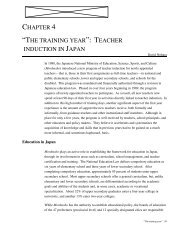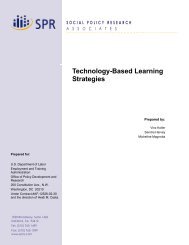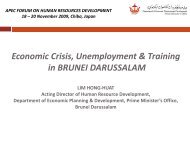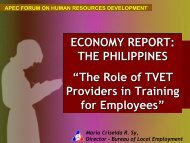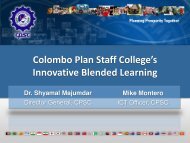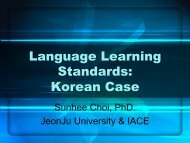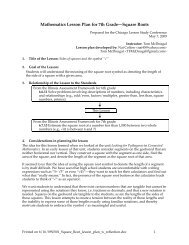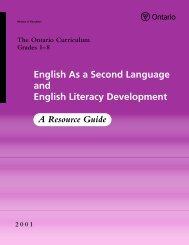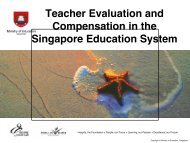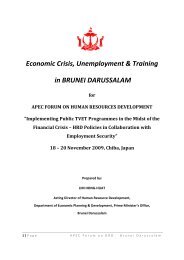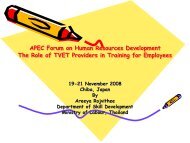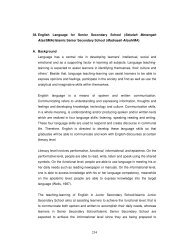Quality Assurance Systems in Asia-Pacific Economic Cooperation
Quality Assurance Systems in Asia-Pacific Economic Cooperation
Quality Assurance Systems in Asia-Pacific Economic Cooperation
You also want an ePaper? Increase the reach of your titles
YUMPU automatically turns print PDFs into web optimized ePapers that Google loves.
ENHANCEMENT OF QUALITY ASSURANCE SYSTEMS IN HIGHER EDUCATION IN APEC MEMBER ECONOMIES<br />
appeals committee is expected to function <strong>in</strong>dependently and provide fair judgement about<br />
the appeal.<br />
Follow-up<br />
In some economies, the responsibility and formal role of the quality assurance agency ends<br />
with the review. The <strong>in</strong>stitutions are responsible for the plann<strong>in</strong>g and implementation of followup<br />
measures. Depend<strong>in</strong>g on the nature of the recommendations, the m<strong>in</strong>istries of education<br />
or other stakeholders may react on the review. Some quality assurance agencies have built-<strong>in</strong><br />
follow-up procedures with vary<strong>in</strong>g levels of rigour; some require b<strong>in</strong>d<strong>in</strong>g actions to be taken by<br />
the HEIs and <strong>in</strong> other cases it may be left to the professional commitment that can be<br />
expected of the HEIs.<br />
Yet another approach is to l<strong>in</strong>k the follow-up to the subsequent reviews. In this approach,<br />
follow-up is the responsibility of the <strong>in</strong>stitution, but QA decisions are valid for a specific<br />
duration and follow-up is a strong consideration at the next review. This option l<strong>in</strong>ks the<br />
quality assurance cycles <strong>in</strong> various ways. The agency may choose to check on earlier<br />
recommendations and base its subsequent QA decisions on how the <strong>in</strong>stitution or program<br />
has acted on those recommendations.<br />
There is an <strong>in</strong>creas<strong>in</strong>g acknowledgement <strong>in</strong> the region that follow-up should be added to the<br />
essential methodological pr<strong>in</strong>ciples.<br />
<strong>Quality</strong> Enhancement<br />
<strong>Quality</strong> assurance is a resource <strong>in</strong>tensive exercise for the HEIs as well as the QA systems<br />
and to benefit optimally from such an exercise it is essential that the HEIs are helped further<br />
to build on the QA outcome and enhance the quality of their provisions. Many QA systems of<br />
the APEC region consider the participatory QA process itself as the ma<strong>in</strong> quality<br />
enhancement (QE) activity. Over and above help<strong>in</strong>g HEIs to benefit from the QA exercise per<br />
se, a suite of <strong>in</strong>itiatives are also be<strong>in</strong>g attempted by the QA systems. Some have <strong>in</strong>centives<br />
and fund<strong>in</strong>g schemes to support quality enhancement <strong>in</strong>itiatives.<br />
Some QA systems steer the post-QA process follow-up strategies towards quality<br />
enhancement. They facilitate cont<strong>in</strong>uous <strong>in</strong>teraction with the HEIs through sem<strong>in</strong>ars and<br />
various academic fora. Support<strong>in</strong>g projects that would enhance certa<strong>in</strong> aspects of quality<br />
education, runn<strong>in</strong>g select projects and do<strong>in</strong>g research on areas that need attention to<br />
enhance quality, <strong>in</strong>volv<strong>in</strong>g a cross-section of <strong>in</strong>stitutional members <strong>in</strong> consultations and<br />
discussions on quality enhancement, and support<strong>in</strong>g network<strong>in</strong>g among HEIs are a few<br />
<strong>in</strong>itiatives found among quality assurance agencies that contribute to QE of HEIs.<br />
The publication program of quality assurance agencies can have a significant impact through<br />
publication of guidel<strong>in</strong>es, handbooks and resource materials for the use of HEIs. Tra<strong>in</strong><strong>in</strong>g<br />
programs for quality managers or steer<strong>in</strong>g committee coord<strong>in</strong>ators and reviewers and<br />
<strong>in</strong>volv<strong>in</strong>g them <strong>in</strong> quality assurance exercises develops an academic community who are<br />
sensitised to quality-related issues and who <strong>in</strong> turn contribute to QE of their own HEIs.<br />
<strong>Quality</strong> of <strong>Quality</strong> <strong>Assurance</strong><br />
Monitor<strong>in</strong>g QA<br />
<strong>Quality</strong> assurance agencies have the obligation to demonstrate that the quality assurance<br />
process as implemented by them achieves the desired objectives effectively. To this end, they<br />
become accountable to many stakeholders to prove the credibility of the process and to<br />
ensure the objectivity of the outcome. Network<strong>in</strong>g, <strong>in</strong>formation shar<strong>in</strong>g with <strong>in</strong>ternational<br />
counterparts, participation <strong>in</strong> <strong>in</strong>ternational events and discussions and self-monitor<strong>in</strong>g, most of<br />
which are either <strong>in</strong>ternal or <strong>in</strong>formal or ad hoc, are the predom<strong>in</strong>ant ways QA systems follow<br />
to ensure their quality. A few good examples of systematic, external reviews are also seen.<br />
Good practice identified by INQAAHE <strong>in</strong>dicates that QA systems should be able to practice<br />
what they preach and demonstrate their quality to the stakeholders <strong>in</strong> a more systematic<br />
manner.<br />
xviii



